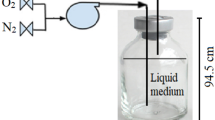Abstract
2,4-Dichloro-cis,cis-muconate is established as ringcleavage product in the degradation of 3,5-dichlorocatechol by Alcaligenes eutrophus JMP 134. The formerly described isomerization of 2-chloro-trans- to 2-chlorocis-4-carboxymethylenebut-2-en-4-olide as an essential catabolic step could not be certified.
Similar content being viewed by others
References
Beadle CA, Smith ARW (1982) The purification and properties of 2,4-dichlorophenol hydroxylase from a strain of Acinetobacter species. Eur J Biochem 123:323–332
Bollag J-M, Briggs GG, Dawson JE, Alexander M (1968) 2,4-D metabolism. Enzymatic degradation of chlorocatechols. J Agr Food Chem 16:829–833
Chatterjee DK, Kellogg ST, Hamada S, Chakrabarty AM (1981) Plasmid specifying total degradation of 3-chlorobenzoate by a modified ortho-pathway. J Bacteriol 146:639–646
DeBoer TJ, Backer HJ (1954) A new method for the preparation of diazomethane. Rec Trav Chim 73:229–234
Don RH, Weightman AJ, Knackmuss HJ, Timmis KN (1985) Transposon mutagenesis and cloning analysis of the pathways for the degradation of 2,4-dichlorophenoxyacetic acid and 3-chlorobenzoate in Alcaligenes eutrophus JMP 134 (pJP4). J Bacteriol 161:85–96
Dorn E, Knackmuss HJ (1978a) Chemical structure and biodegradability of halogenated aromatic compounds. Two catechol 1,2-dioxygenases from a 3-chlorobenzoate-grown Pseudomonad. Biochem J 174:73–84
Dorn E, Knackmuss HJ (1987b) Chemical structure and biodegradability of halogenated aromatic compounds. Substituent effects on the 1,2-dioxygenation of catechol. Biochem J 174:85–94
Dorn E, Hellwig M, Reineke W, Knackmuss HJ (1974) Isolation and characterization of a 3-chlorobenzoate degrading Pseudomonad. Arch Microbiol 99:61–70
Evans WC, Smith BSW, Fernley HN, Davies JI (1971) Bacterial metabolism of 2,4-dichlorophenoxyacetate. Biochem J 122: 543–551
Haigler BE, Nishino SF, Spain JC (1988) Degradation of 1,2-dichlorobenzene by a Pseudomonas sp. Appl Environ Microbiol 54:294–301
Kalinowski HO, Berger S, Braun S (1984) 13C-NMR-Spektroskopie. Thieme, Stuttgart New York, p 470
Kuhm AE, Schlömann M, Knackmuss HJ, Pieper DH (1990) Purification and characterization of dichloromuconate cycloisomerase from Alcaligenes eutrophus JMP 134. Biochem J 266:877–883
Pemberton JM, Corney B, Don RH (1979) Evolution and spread of pesticide degrading ability among soil micro-organisms. In: Timmis KN, Pühler A (eds) Plasmids of medical, environmental and commercial improtance. Elsevier/North-Holland Biomedical Press, Amsterdam, pp 287–299
Pieper DH, Reineke W, Engesser KH, Knackmuss HJ (1988) Metabolism of 2,4-dichlorophenoxyacetic acid 4-chloro-2-methylphenoxyacetic acid and 2-methylphenoxyacetic acid by Alcaligenes eutrophus JMP 134. Arch Microbiol 150:95–102
Perkins EJ, Gordon MP, Caceres O, Lurquin PF (1990) Organization and sequence analysis of the dichlorophenol hydroxylase and dichlorocatechol oxidative operons of plasmid pJP4. J Bacteriol 172:2351–2359
Reineke W, Knackmuss HJ (1984) Microbial metabolism of haloaromatics. Isolation and properties of a chlorobenzenedegrading bacterium. Appl Environ Microbiol 47:395–402
Schmidt E, Knackmuss HJ (1980) Chemical structure and biodegradability of halogenated aromatic compounds. Conversion of chlorinated muconic acids into maleoylacetic acid. Biochem J 192:339–347
Schmidt E, Remberg G, Knackmuss HJ (1980) Chemical structure and biodegradability of halogenated aromatic compounds. Halogenated muconic acids as intermediates. Biochem J 192:331–337
Schraa G, Boone ML, Jetten MSM, van Neerven ARW, Colberg PJ, Zehnder AJB (1986) Degradation of 1,4-dichlorobenzene by Alcaligenes sp. strain A175. Appl Environ Microbiol 52:1374–1381
Schwien U, Schmidt E, Knackmuss HJ, Reineke W (1988) Degradation of chlorosubstituted aromatic compounds by Pseudomonas sp. strain B 13: fate of 3,5-dichlorocatechol. Arch Microbiol 150:78–84
Sistrom WR, Stanier RY (1954) The mechanism of formation of β-ketoadipic acid by bacteria. J Biol Chem 210:821–836
Tiedje JM, Duxbury JM, Alexander M, Dawson JE (1969) 2,4-D metabolism: pathway of degradation of chlorocatechols by Arthrobacter sp. J Agr Food Chem 17:1021–1026
Author information
Authors and Affiliations
Rights and permissions
About this article
Cite this article
Pieper, D.H., Kuhm, A.E., Stadler-Fritzsche, K. et al. Metabolization of 3,5-dichlorocatechol by Alcaligenes eutrophus JMP 134. Arch. Microbiol. 156, 218–222 (1991). https://doi.org/10.1007/BF00249118
Received:
Accepted:
Published:
Issue Date:
DOI: https://doi.org/10.1007/BF00249118




